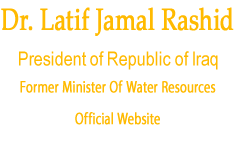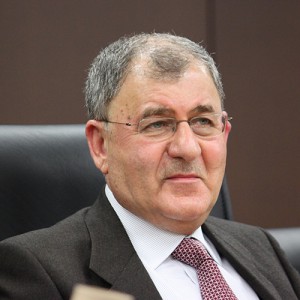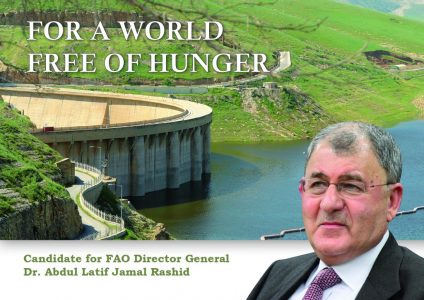Valuing Vital Resources Food, Water and Energy Cost and Policy Options in Gulf.
Valuing Vital Resources: Food, Water and Energy Cost and Policy Options in Gulf.
A workshop jointly convened between a Chatham House (Royal Institute of International Affairs)
and the Kuwait Foundation for the Advancement of Sciences (KFAS
17-18 December 2013 / Kuwait
Policies affecting food and water use and the experience with charging for irrigated water
Presentation by:
Dr. Latif Rashid
Senior Advisor to the Iraqi President
Former Minister of Water Resources
December 2013
Iraq is a good example of the so-called Water, Food and Energy Nexus. They are strongly interconnected both on the production and the consumption sides. The stresses on these resources now seriously impact on stability. In particular, there is growing risk of conflict over control over scarce water sources due to poor or non-existent trans-boundary cooperation and high population growth.
The lack of an internationally agreed upon definition of water security is problematic for Iraq. The United Nations Food and Agriculture Organization (FAO)’s definition of food security has been generally agreed upon worldwide but the link between access to water and ability to achieve food security has not. For example, irrigation can increase soil productivity by 100 to 400 times.
As Iraq’s agriculture is a primarily irrigated agriculture, the impact of declining water resources from damming and diversion of waters in Turkey, Syria and Iran on food security - particularly subsistence agriculture - has been significant. Likewise, the FAO estimates that 20-30% of the cost of the food on the table is related to power but in Iraq, this may be as much as double given the destruction of power facilities and infrastructure through war and the expensive failures of government to solve chronic power shortages in the country.
Iraq faces critical water security issues. While the region (Middle East) has about 15% of the world’s population, fresh water availability is only 1% of the world total. Water availability is also highly seasonal. 75% of river flows are available between the months of February – June, while only 10% is available during the period of maximum irrigation demand between July and October.
Where agriculture constitutes 87% of water use, this limited availability of water creates acute stresses on water supply.
Agriculture must also compete with demands for flood control, municipal and industrial water supply, hydropower, and environmental restoration. As a consequence, Iraq’s water insecurity is inexorably linked with issues of food and energy security which vividly illustrate the “water, food, and energy nexus”. As a downstream country, Iraq has been adversely affected by dam construction projects since the 1970s in neighbouring countries further upstream. The Iran-Iraq war and the 2003 Anglo-American invasion have also taken their toll on Iraq’s hydro sector and irrigation infrastructures. Whereas hydropower used to represent about 25% of Iraq’s electricity needs in the 1990s, it has only been able to operate at 30% of its design capacity over the past 10 years. Climate change and increasing water use by the upstream riparian states is likely to further decrease output from existing plants although there are some plans for new ones.
The upstream damming and diversion of water has also adversely affected Iraqi agriculture by reducing the amount of water available for more intensive irrigation. Iraq should be able to double its food production but is presently unable to due to the reduced availability of power and water.
Moreover, this reduced availability is also felt on the consumption side. This has resulted in the costly “Public Distribution System” (Bitaqa Tamwiniya) to subsidize food production through oil revenue. This initially benefitted the poorer families during the early post-war period but has since become inefficient and urgently needs reform. The reasons for inefficient PDS are:
Rules and regulation related to purchasing food items.
Lack of proper logistics such as transportation and modern storage capacities.
Security situation in certain areas.
Recommendation to improve the system will not be easy. An alternative to PDS will be to reduce the PDS and concentrate on the groups with low standard of living. Compensate these groups of population with cash subsidy similar to social security system.
The Government of Iraq has pursued several initiatives to address its water security issues.
Charges for water use amongst farmers were imposed by the government in 1995 and it was specified in 2004. The fees for irrigated water varied from 500 Iraqi diners (ID) to 2500 ID per donme (2500 m2) depending on type of irrigation used. The programme was administered by the staff of the Ministry of Water Resources. The method of irrigation and further recommendations to farmers such as agricultural extension and new methods of irrigation are administered by the Ministry of Agriculture. The overall system has to be improved before cost effective collection is made and process of metering introduced. The authorities made an effort between 2004-2005 to collect fees but the total fees collected amounted to under half of the cost of the programme’s administration. In 2006, the Council of Ministers agreed to postpone the programme until further notice.
Second, Iraq has taken steps to establish a National Water Council to consolidate the water sector and develop a long-term strategy for water reforms and water management. Finally, Iraq is keen to engage in water-sharing agreements with neighbouring countries, particularly Iran and Turkey, to ensure the accessibility of water resources for Iraq’s agricultural and power sectors across time and space. The two need to be coordinated because Iraq’s long term strategy for water reforms and water management need be informed by the water demand projections and management plans of the other riparian states.
Curriculum Vitae
10th August 1944 / Sulaimaniya, Iraq
Read More



